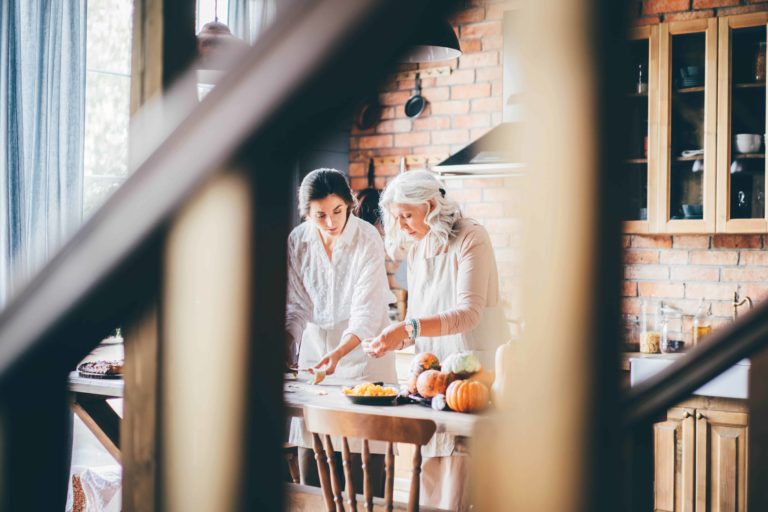
Author of 10 novels including How to Change a Life, freelance food writer/recipe developer and culinary consultant for The Self-Care Cookbook by Dr. Frank Ardito.
Printing family recipes can preserve memories, independence
When I first met my husband, his mother was already having some health struggles. She had recovered, but not completely, from a stroke several years earlier. And she was stoically suffering from the double whammy of macular degeneration and the early stages of dementia. Despite her challenges, she still deeply wanted to cook for her family. Yet, her role as caretaker and nurturer was slowly shifting away from her. Losing the ability to feed her family added a layer of distress.
On my first visit to meet the family, I was heartbroken to watch her in the kitchen, holding a faded recipe card two inches from her face in order to make her famous chocolate sheet cake — her son’s favorite treat and a cherished family recipe. Looking at that recipe card with its tiny spidery handwriting, one thing was clear: We had to preserve the family recipes and preserve Mom’s ability to make them for as long as she was able.
A few months later, for Mother’s Day, we sent her a binder of all the family recipes, typed and printed in a bold large font, arranged in clear plastic protectors, and assembled into a custom cookbook. It wasn’t terribly pretty, but it was effective. And it was a gift that kept on giving. The cookbook gave Mom independence and gave all of us comfort knowing that the recipes weren’t lost. She used the cookbook until her diseases made cooking impossible, but we know it extended her culinary activities significantly.
I reached out to Renée Rentmeester, the creator and executive producer of the Cooking Without Looking TV show and podcast — the first TV show featuring on-air talent with vision impairments or blindness — to find out about the benefits of a family cookbook for those who are dealing with sight diminishment due to age or disease.
“There is something so compassionate when the caregiver creates this for the person they are caring for.”
“Creating a large-print cookbook of recipes for a friend or family member who is losing their sight along with their cognitive skills is tremendous on so many levels,” Rentmeester says. “First, it gives the person you are caring for more of a feeling of being in control. Even though they may be losing their sight, they have a new way to prepare the foods they love while staying independent, which is the key word for anyone who may be incurring a disability.”
When creating your own cookbook, be sure to clarify any confusing or incomplete recipes. Explain any tips or techniques that weren’t originally written down. It can be a helpful, bonding experience to cook some recipes together and note anything that’s missing or unclear.
Be sure to print the recipes in a large font that the recipient can easily read, and put each recipe in a protective clear plastic sleeve. If your loved one uses a light box to assist with reading, be sure that you assemble the cookbook in a binder with easily removable pages. Only print on one side of the paper to prevent shadow or bleed-through.
“There is something so compassionate when the caregiver creates this for the person they are caring for, especially if that person is a parent,” Rentmeester says. “The parent often has been the one the child has looked up to all of their lives. When the roles change, the parent doesn’t want to admit they need help. When the child [or] caregiver takes the step to do something so filled with empathy, the parent feels more comfortable confiding their needs, which often is a difficult thing to do.”

Simple Pear Cake
Serves 8
This adaptation of a family recipe requires no mixer or special equipment, which makes it wonderful for cooks who might be having challenges in the kitchen. Use Bosc or Bartlett pears or any variety that is sweet and crisp. If you have problems chopping, use canned diced pears. You can also adapt to your taste, such as using apples or plums instead of pears. This pear cake is a not-too-sweet snacking cake, so don’t limit it to dessert. It is perfect for breakfast, brunch, afternoon coffee, or tea.
 Ingredients
Ingredients
• 1 cup flour
• 3/4 cup sugar
• 1 teaspoon cinnamon
• ½ teaspoon baking soda
• Pinch salt
• 2 large eggs
• ½ cup vegetable oil
• 1 teaspoon pure vanilla extract
• 2 cups peeled and cubed pears (about 2 medium pears, or substitute diced canned pears in juice, well-drained)
Method
Heat oven to 325°F. Grease an 8×8-inch baking pan or muffin tins.
Combine flour, sugar, cinnamon, baking soda, and salt in a large bowl. Whisk with a fork to combine.
In a smaller bowl, whisk eggs, oil, and vanilla until smooth.
Stir the wet into the dry ingredients until a thick batter is formed. Mix in pears and spread batter into prepared pan.
Bake 35-40 minutes* until a skewer inserted in the middle comes out clean. Cool completely before cutting.








